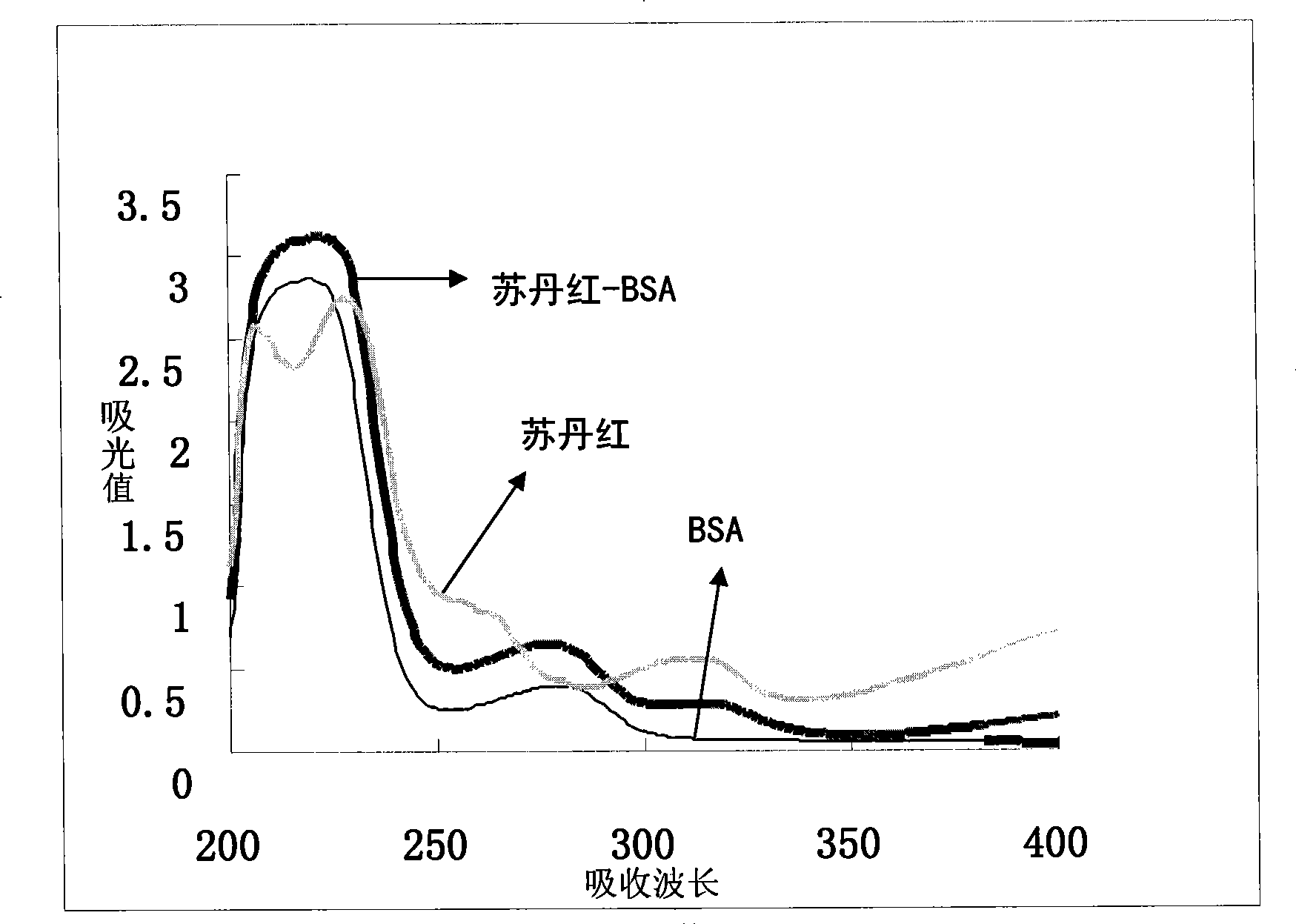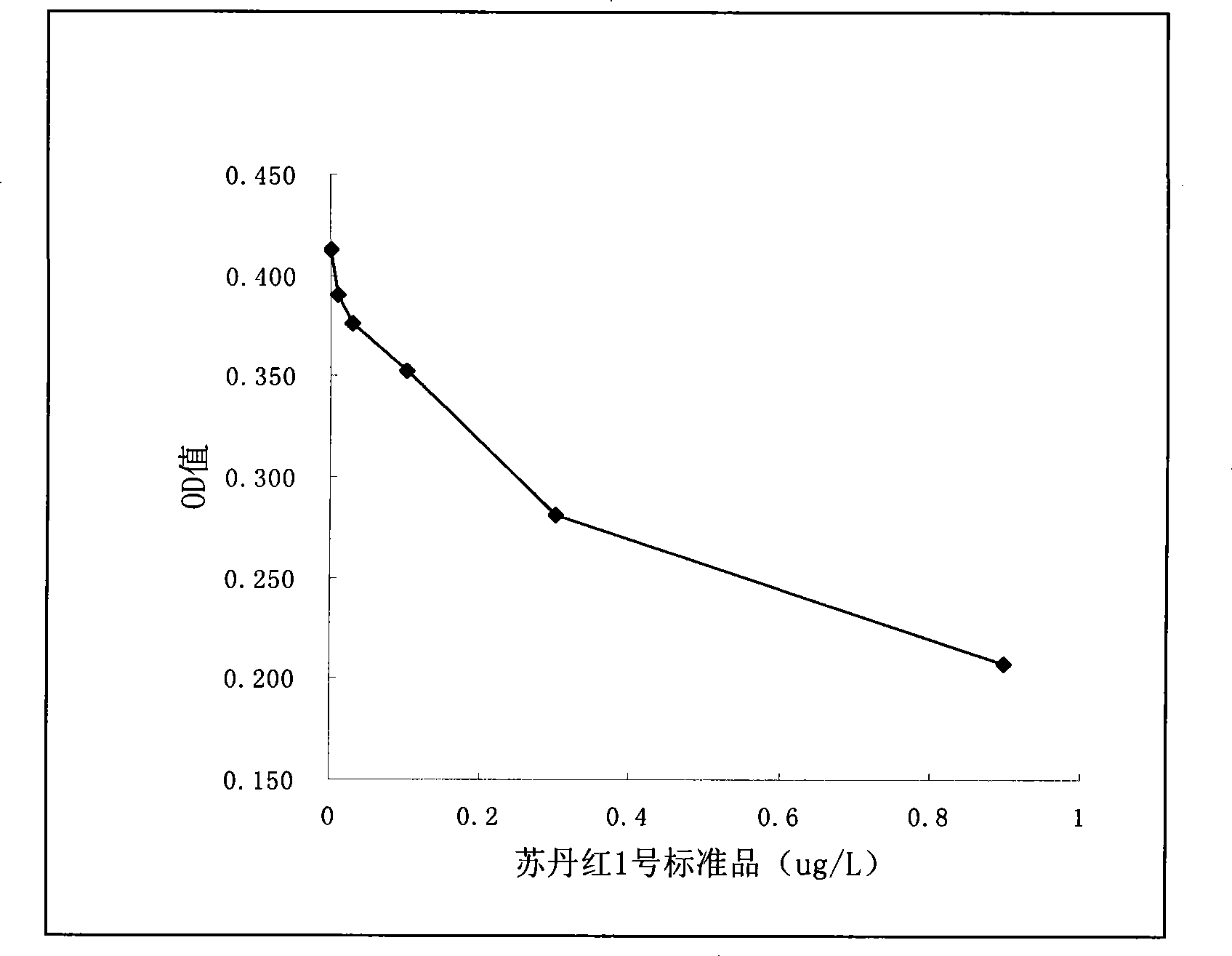Preparation of monoclonal antibody and uses thereof
A monoclonal antibody and immune antigen technology, applied in the field of immunochemical analysis, can solve the problems of time-consuming, laborious, high instrument cost, unfavorable sample detection, etc.
- Summary
- Abstract
- Description
- Claims
- Application Information
AI Technical Summary
Problems solved by technology
Method used
Image
Examples
Embodiment 1
[0028] Example 1: Synthesis of Antigens
[0029] The molecular structural formula of carboxy sudan red is as follows:
[0030]
[0031]In a 100-mL beaker, add 140mg of carboxysudan red and dissolve in 3mL of N,N-dimethylformamide (DMF), add 103.2mg of dicyclohexylcarbodiimide (DCC) and 75mg of N-hydroxysuccinate while stirring imide (NHS), stirred overnight at room temperature. The next day, the precipitate was removed by centrifugation, and the supernatant was taken for later use. Take another 100-mL beaker, add 5mL 0.1mol / LPBS (pH 7.2), 340mg BSA, stir on a magnetic stirrer, add 0.5mL N,N-dimethylformamide (DMF) until the BSA dissolves, and then The above supernatant was slowly added dropwise while stirring, the mouth of the beaker was sealed, and the reaction was stirred and reacted at 4°C for 4h. After centrifugation, the precipitate was removed, and the supernatant was loaded into a dialysis membrane and dialyzed with normal saline at 4°C for 3 days, and the medium ...
Embodiment 2
[0034] Embodiment 2: Preparation of monoclonal antibody
[0035] (1) Animal immunity
[0036] Ten female Balb / C mice were differentiated into 2 groups, 5 mice in the immune group and 5 mice in the negative control group.
[0037] The carboxy sudan red I-BSA immunization antigen was diluted with physiological saline, and the immunization dose of each mouse was 50ug / only. The immunization program used 2 basic immunizations and 3 booster immunizations, and the interval between each immunization was 15 days. The first basic immunization was immunized with Freund's complete adjuvant emulsified antigen, and multi-point subcutaneous injection was used on the back of the mouse neck; the second basic immunization and the subsequent two booster immunizations were used to emulsify the antigen with Freund's incomplete adjuvant, using mouse Multi-point subcutaneous injection or intraperitoneal injection on the back of the neck; the last booster immunization uses the antigen without adjuv...
Embodiment 3
[0046] Example 3: Identification of Monoclonal Antibodies - Indirect ELISA Method
[0047] (1) Determination of the optimum antigen coating concentration and the optimum dilution factor (working concentration) of the antibody
[0048] The checkerboard titration test using the indirect ELISA detection method was carried out, and the point where the absorbance value (OD) was about 1.0 was used as a reference point, and factors such as antigen concentration and antibody dilution were comprehensively considered to determine the optimal antigen coating concentration and antibody optimal concentration. Dilution factor (i.e. working concentration).
[0049] The operating procedure of the indirect ELISA detection method: Take a 96-well microtiter plate, add 100ul of the coating antigen carboxy Sudan Red-OVA at a coating concentration diluted with coating buffer to each well, coat overnight at 4°C, wash with washing solution 0.05 Wash the plate 3 times with %PBST, add 300ul of blockin...
PUM
 Login to View More
Login to View More Abstract
Description
Claims
Application Information
 Login to View More
Login to View More - R&D
- Intellectual Property
- Life Sciences
- Materials
- Tech Scout
- Unparalleled Data Quality
- Higher Quality Content
- 60% Fewer Hallucinations
Browse by: Latest US Patents, China's latest patents, Technical Efficacy Thesaurus, Application Domain, Technology Topic, Popular Technical Reports.
© 2025 PatSnap. All rights reserved.Legal|Privacy policy|Modern Slavery Act Transparency Statement|Sitemap|About US| Contact US: help@patsnap.com



